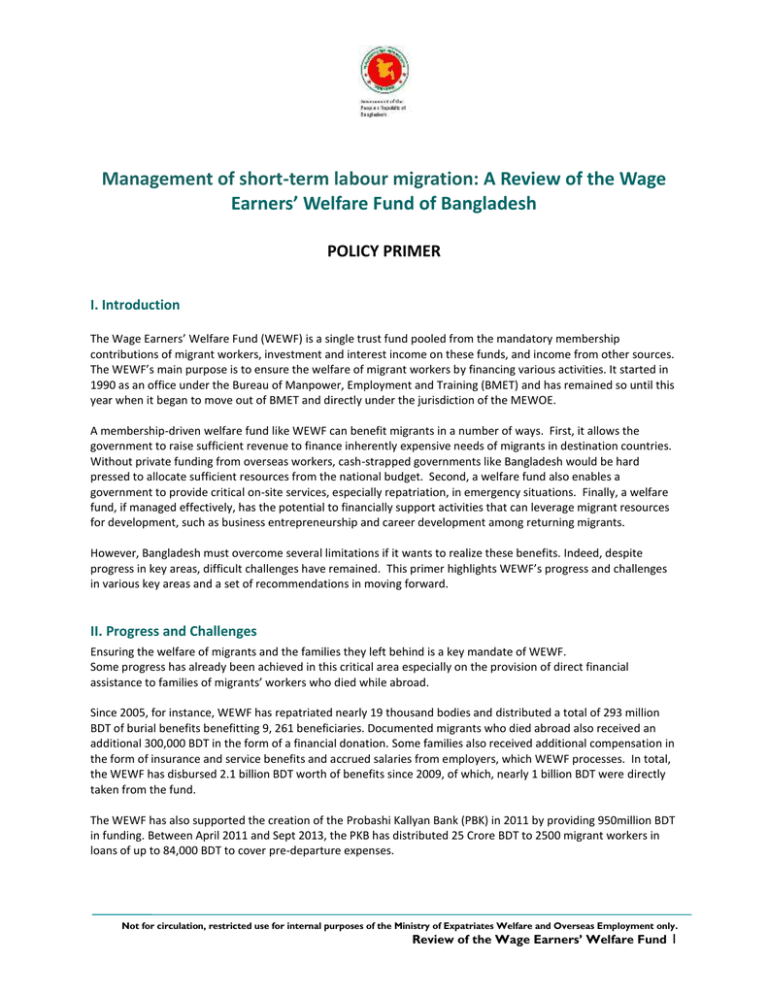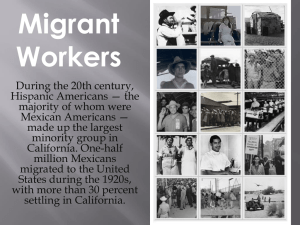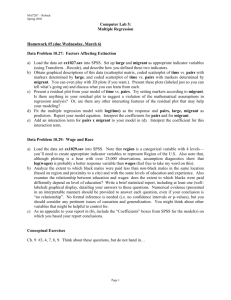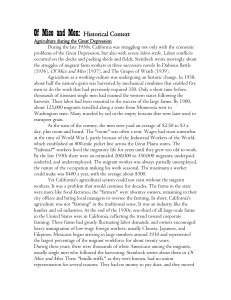Management of short-term labour migration: A Review of the Wage
advertisement

Management of short-term labour migration: A Review of the Wage Earners’ Welfare Fund of Bangladesh POLICY PRIMER I. Introduction The Wage Earners’ Welfare Fund (WEWF) is a single trust fund pooled from the mandatory membership contributions of migrant workers, investment and interest income on these funds, and income from other sources. The WEWF’s main purpose is to ensure the welfare of migrant workers by financing various activities. It started in 1990 as an office under the Bureau of Manpower, Employment and Training (BMET) and has remained so until this year when it began to move out of BMET and directly under the jurisdiction of the MEWOE. A membership-driven welfare fund like WEWF can benefit migrants in a number of ways. First, it allows the government to raise sufficient revenue to finance inherently expensive needs of migrants in destination countries. Without private funding from overseas workers, cash-strapped governments like Bangladesh would be hard pressed to allocate sufficient resources from the national budget. Second, a welfare fund also enables a government to provide critical on-site services, especially repatriation, in emergency situations. Finally, a welfare fund, if managed effectively, has the potential to financially support activities that can leverage migrant resources for development, such as business entrepreneurship and career development among returning migrants. However, Bangladesh must overcome several limitations if it wants to realize these benefits. Indeed, despite progress in key areas, difficult challenges have remained. This primer highlights WEWF’s progress and challenges in various key areas and a set of recommendations in moving forward. II. Progress and Challenges Ensuring the welfare of migrants and the families they left behind is a key mandate of WEWF. Some progress has already been achieved in this critical area especially on the provision of direct financial assistance to families of migrants’ workers who died while abroad. Since 2005, for instance, WEWF has repatriated nearly 19 thousand bodies and distributed a total of 293 million BDT of burial benefits benefitting 9, 261 beneficiaries. Documented migrants who died abroad also received an additional 300,000 BDT in the form of a financial donation. Some families also received additional compensation in the form of insurance and service benefits and accrued salaries from employers, which WEWF processes. In total, the WEWF has disbursed 2.1 billion BDT worth of benefits since 2009, of which, nearly 1 billion BDT were directly taken from the fund. The WEWF has also supported the creation of the Probashi Kallyan Bank (PBK) in 2011 by providing 950million BDT in funding. Between April 2011 and Sept 2013, the PKB has distributed 25 Crore BDT to 2500 migrant workers in loans of up to 84,000 BDT to cover pre-departure expenses. Not for circulation, restricted use for internal purposes of the Ministry of Expatriates Welfare and Overseas Employment only. Review of the Wage Earners’ Welfare Fund 1 Despite success in these important areas, however, the WEWF still faces difficult challenges in fulfilling its mandate, of which five key areas require immediate attention. First, there is a serious delay in distributing WEWF death benefits. A review of 47 actual cases of WEWF claims that were disbursed from January to July 2013 in DEMO Dhaka suggests lag between the migrants’ date of death and the disbursal of the benefit. For instance, it took an average of about 685 days by the time the migrant died abroad to the time the burial benefit is disbursed to the beneficiary. Migrants’ beneficiaries also do not necessarily apply for burial benefits as soon as they learn of their relatives’ death but wait on average of about 388 days. The waiting times for financial donation and private insurance and other benefits are even longer, averaging at 814 days and 945 days respectively. These 47 cases highlight the serious delay in dispensing WEWF death related benefits. The delay happens even before the application for claims was filed at WEWF since migrant families wait months and sometimes even years before filing for a claim. The review team’s focus group discussions with migrant families who have filed claims suggest that the delay arise from many factors. Migrant families are not always aware that the benefit is available. Indeed, in the survey commissioned for this review, an overwhelming majority of migrants answered no to the question, “Have you heard of the Wage Earners Welfare Fund?” Others face difficulty in getting the requirements needed to file the application. These two reasons may explain the lag time between the date of death and the actual application for the benefit. Migrant families also report visiting the WEWF many times to follow-up with their cases once they are filed. Those living outside of Dhaka had the hardest experience given the transportation and lodging costs incurred and the time wasted commuting. Indeed, interviews with government officials suggest that the process would have been shorter if the claims were filed sooner or if they don’t need to go to Dhaka to process claims for financial donations and other death-related compensations. Second, there is a concern that the benefits are inadequate and that the fund is not properly utilized to meet migrant workers’ needs. There is a concern across various stakeholders that the fund is not properly utilized. For some, the fund is being used to pay for services, infrastructure and facilities that should fall under the government’s responsibilities while others expect the fund to finance a wider array of benefits beyond deathrelated compensations. Currently, the WEWF has estimated assets of 10.8 billion BDT, nearly half (4 billion BDT) is invested in fixed term deposits (FDR). WEWF’s expenditures from fiscal years 2010 to 2013 shows that the Fund spent less on items that provide direct welfare services to migrants. Indeed, capital expenditures have eaten up much of the expense allocation during those three years, with the biggest outflow going to the PBK amounting to 950 million BDT followed by the expenditure related to the construction of the Welfare building (283 million BDT) “Unexpected costs” and “Other expenses” amounting to 45 million BDT and 107 million BDT respectively comprised 11.49 percent of the total expenditures in fiscal year 2010-2011. Interestingly, these expenses if combined had exceeded the total welfare benefits paid out in the same fiscal year, which only accounted for 8.89 percent. This expenditure pattern may be interpreted positively or negatively. WEWF may be spending less on direct services to migrants now so more is available for future services to future members. At the same time, however, it may also mean WEWF is simply underinvesting in services. Third, there is a concern over the fund’s continued viability. Indeed, the review team interviews with key WEWF board members suggest strongly that viability has been the prime consideration in their allocation decisions so far. Fund managers expect that expenditures will increase in the coming years due to expected increase in claims for death and other benefits. Thus, as explained earlier, the WEWF board chose to invest in income generating activities to lower risks of fund depletion. The review team’s analysis of WEWF’s income statement for the last three fiscal years suggest that majority of income is currently sourced from welfare fees and processing fees, which are dependent solely on the volume of Not for circulation, restricted use for internal purposes of the Ministry of Expatriates Welfare and Overseas Employment only. 2 Review of the WEWF deployment each year. If deployment continues to increase, then the fund is expected to grow steadily. Based on the discussions with BMET, they target higher deployment volume in the years to come. However, there is always the possibility of drastic decline in deployment (which happened in 2013 and in years 2009 and 2010 when deployment was half of the previous year) and this will pose a great risk to the fund levels. The second biggest source of income is the returns from the invested assets. In the last three fiscal years, these assets earned around 931 million BDT in total. Interest income received from FDR, which dwarfs income from other invested assets, has consistently increased while others, such as income from short term deposits have decreased. However, in recent years, the market yield rates have steadily decline. If this trend continues, which many global economists think it would, then the fund is at risk of reduced income from its investments. Indeed, a stress test 1 conducted to understand the fund’s sensitivity to three different scenarios— declining deployment, decrease in the Fund’s rate of return and an increase in migrant workers— finds that WEWF exhibits the highest sensitivity to the decline in deployment. More than 50 percent of the income is derived from the welfare fees and other fees related in processing the overseas employment of the migrant workers. If the recent drastic decline in 2013 in the overseas employment continues over the next 10 years, the Fund will be at risk of depletion due to the decline in the welfare fees and other related income starting as early as 2016. Maintaining the historical experience of the other parameters, the Fund is also at risk if the interest rates decline by at least 50 basis points per year. At this rate, the fund would start losing money by 2022. Increasing death rates among migrant workers would also increase expenditures by 36 percent from 857 million BDT in 2013 to nearly 1.2 billion by 2023, and the fund would start depleting by 2020. Fourth, the WEWF operates on an inadequate legal and regulatory framework. The Welfare Fund Rules of 2002 do not provide adequate provisions to ensure accountability and minimize chances for abuse of power foremost of which is the lack of migrant worker representation in WEWF’s Board. Given that an overwhelming majority of the fund’s income is currently sourced from migrants’ welfare and processing fees, it is surprising that the Rules did not provide even a single seat for migrant workers or their representatives at the 11-member Board. The lack of migrant representation is an important omission since the Board under the Rules is quite powerful. For instance, the Board exercises tremendous influence in how the funds can be used. Although Article 7 lists the types of activities the WEWF may fund, Article I also states that the Fund can also “finance any other projects determined by the Board.” Fifth, WEWE service information is not easily accessible and information about its performance is missing from the public domain. A result of a close reading of current practices shows lack of information about welfare services among the migrant workers and their families and absence of guidelines for digitalization of information about them. The governance of the WEWF is not tripartite and there seems to be greater consensus about lack of transparency in WEWF management. From the existing approaches to welfare, it is not clear that how criteria for selection of beneficiaries are made and how services to be delivered are determined. It is also not clear how the complex nature of selection of possible investments is investigated and risks analyzed. The need to put forward a possible common ground for selection of beneficiaries and welfare services in Bangladesh and overseas by the tripartite stakeholders remains unmet. There also remains a need to treat the fund with an eye to the risks and take investment decisions in a transparent manner. The problem is accentuated by the fact that no aspect of WEWF has been brought under the digitalization process so far and an open and communicative approach to help structure the decision-making process, vital part of good governance of the WEWF, is lacking. 1 Stress test is the process of determining the impact of risk factors to a system under several scenarios outside the normal expected levels. Not for circulation, restricted use for internal purposes of the Ministry of Expatriates Welfare and Overseas Employment only. Review of the Wage Earners’ Welfare Fund 3 Lastly, WEWF suffers from a weak institutional capacity. For instance, efficiency is impeded by a lack of welldocumented set of business processes within WEWF. There is no agreed timeline for how long particular activities are supposed to be completed which contributes to the delay in service delivery and consequently the strong reliance on agents to help migrants maneuver through an opaque system. There is also a challenge in effectively implementing decentralization of functions particularly with the DEMOs and Labor Wings. Many of WEWF activities and services remain too centralized. Most of the services of WEWF remain in Dhaka, increasing the cost of migration for migrants and their families. BMET and the WEWF also do not have clear working relationships with each other, which negatively impacts service delivery. For instance, BMET mobilizes migrant workers’ contribution that is the primary source of income for the WEWF and this set-up conflates what role should BMET and WEWF is each responsible for. There is a growing sense among staff that BMET and WEWF are actually in competition due to the lack of clarity and responsibilities and mandate. Although monitoring and reporting of projects do occur, reports are not easily accessible nor are they analyzed, digested and presented in a format that can inform policy or operations. This knowledge gap negatively affect and constrained decision making at various levels of operation and policymaking. V. Options for Reform: Nine Steps Forward Fund stewardship that is transparent, judicious and responsive to the requirements of Bangladeshi migrants, and their families, is a tall order. A closer look at WEWF’s operations points to eight areas where reform is both needed and feasible, especially in the short term. 1. Update the legal and regulatory framework. Checks and balances should be instituted in the Welfare Fund rules to maximize accountability and increase transparency. The new law could include the following provisions: Identify the minimum number of meetings the board must have during the year. Ensure that the Fund’s project are subjected to a feasibility study or other measurements that secure the fund’s viability in the long-term while meeting liquidity requirements in the near term. Mandate that projects exceeding a certain amount could be subjected to a “two steps approval” process. Identify a limit for the money invested in each projects, subject to an approval of another authority in the case of exceeding the limit fixed. Provide eligibility conditions for workers and their families. Ensure that procedures have clear timeframes. Subject the withdrawal of the money to serve the goals and objectives of the fund and based on the allocation that was discussed and approved. Subject the Budget to a discussion and approval of another observer or body. Mandate that the Fund employ independent employees, such as auditors and accountants, who do not report to the board. Ensure that the audit report of the comptroller general is accessible, transparent and published by the newspapers or any accessible media. The published report should also contain details about how the money was invested and what is the sum of the money invested in each goal. Give opportunities for members of the civil society, including trade unions and migrants organization, to discuss, investigate and question any of the audit report elements and specify a regulatory mechanisms to guarantee this capacity and goal. 2. Focus on delivering core services and those that can be delivered in an effective manner and meaningful scale and partner with other actors, in both the public and private sphere, in delegating secondary services. A fund’s Not for circulation, restricted use for internal purposes of the Ministry of Expatriates Welfare and Overseas Employment only. 4 Review of the WEWF resources may be adequate to provide core services2, since a relatively small proportion of migrant workers actually experience the most severe problems while working abroad. However, a fund cannot deliver costly secondary services3 on its own based on a small membership fee. WEWF should only extend benefits after serious consideration of its capacity to deliver such benefits in an effective manner and meaningful scale. Partnerships can range from sharing responsibilities to full outsourcing in order to supplement direct capacity. For instance, WEWF should explore partnership with other actors in providing health insurance and loan schemes to migrants. 3. Establish a risk management team to monitor all the risk factors and provide periodic updates on the potential impact of the risk factors to the Fund. The review team also recommends establishing a risk management team to monitor all the risk factors and provide periodic updates on the potential impact of the risk factors to the Fund. An analysis of the historical trend should be considered in forecasting short-term and longterm trend in the benefit pay outs. Furthermore, large-scale emergencies such as the Libya crisis and catastrophic events should also be factored in the simulation model. More specifically, the risk management team could: Advise the Board on how to reduce risk of declining interest rates. It could give options on how to diversify the investment portfolio to other high performing instruments to maintain the desired returns on investment. It could also outline to the Board the appropriate risk mitigating strategies to ensure that the returns are commensurate to the risks to the Fund, and that adequate liquidity is maintained at all times. The team could also lead efforts in reviewing business plans of large investment projects, foremost of which is the investment on Probashi Kallyan Bank. the review team recommends conducting a separate review of its business plan, particularly on the risk control measures that will ensure the long-term sustainability of the bank. One particular concern is the risk of collection and recovery of debts which are highly sensitive to the stability of the contract of the migrant workers. Even in the Philippines, not too long ago, not a lot of banks extend loans to migrant workers due to the inherent uncertainty of the job contracts. Ensuring that the Probashi Kallyan Bank remains sustainable will definitely contribute to the viability of the fund. However, any downward movement in the bank’s sustainability would mean future capital requirement which would more likely be funded from the Fund. 4. Pursue digitalization. On the basis of a close reading of current practices the need of digitilization is a vital part of WEWF management. The overwhelming need for transparency represents the most significant factor of accountability which must be taken into account. Securing the appropriate hardware and software is essential for WEWF to expedite claims and save thousands of Taka on office supplies and allowing for more efficient reporting to the stakeholders. Digitalization should include basic financial management, including vendor payments and travel settlements, and grants management for the approved welfare programme that may be developed in the future. Digitalization would serve different purposes. On a most general level, it will make information accessible to the contributors to the fund and also inform them about the variety of welfare services, how the services and beneficiaries are selected, how to access them, and what the delivery status is. On a practical level, digitalization will ease the decision-making process and promote communication on the issue bringing greater accountability in decision-making. Such communication on fund management is a vital aspect of good governance and as a basic responsibility of the fund management institution. It is, therefore, important that digitalization is undertaken. Core services, those that protect migrant workers from the risks they face while abroad, include repatriation in case of breakdowns in public order, such as war, or in case of other forms of maltreatment; health and life insurance; and legal assistance for settling work-related disputes and frauds. 3 Secondary services help migrant workers before and after departure and the families left behind. These include education and training, reintegration 2 programs (e.g., livelihood loans), and predeparture loans. Not for circulation, restricted use for internal purposes of the Ministry of Expatriates Welfare and Overseas Employment only. Review of the Wage Earners’ Welfare Fund 5 5. Provide spaces for migrant workers in the WEWF Board. Ensuring migrant representation in the WEWF Board particularly significant since they can be an excellent source of feedback from, and other relevant information about, migrant workers. Beyond their functional worth, migrant representation has a symbolic value. Ensuring migrant worker representation in the Board generates trust and ownership in a government-led process. 6. Consider building a contingency fund for mass repatriation in times of crisis. Given that the majority of Bangladeshis work in conflict-prone regions, the WEWF should consider building up a contingency fund for repatriation, perhaps in partnership with international organizations and multi-lateral lending institutions. 7. Upgrade skills of migrant workers and ensure strict implementation of required medical screening. Increasing death rates among migrant workers also expose the Fund to depletion risk. To address this, the WEWF has to ensure implementation of required medical screening to every outgoing migrant worker, and upgrading the skills and training of the migrant workers. These two areas will reduce the likelihood of non-catastrophe-related deaths among migrant workers abroad. 8. Strengthen access to information and link it with information technology. Efficiency is impeded by a lack of well-documented set of business processes within WEWF. Digitalization will certainly help improve the documentation of the business process. WEWF, should consider linking the smart card Ids and smart card-holder designated nominees with the claims of compensation and benefits, opening online and one-stop counters at the Welfare Desks at the international ports of landing and in the DEMOs Bangladesh, and foreign missions of Bangladesh. 9. Monitor progress, measure impact and share results. It is also important for governments to avoid paper schemes and to ensure that the implementation of laws and regulations are closely monitored. Setting a robust and meaningful monitoring and evaluation (M&E) policy that incorporate comprehensive provisions for annual program and financial audits and reporting to stakeholders are critical. The M&E policy allows for frequent adjustments to programs and policy adaptation. It would also help avoid capture by vested interests and shores up the government’s credibility. Not for circulation, restricted use for internal purposes of the Ministry of Expatriates Welfare and Overseas Employment only. 6 Review of the WEWF





